|
|
Snake Magician, Morocco, Marrakech
|
The Wildlife Protection Act of 1972 in India technically proscribes snake charming on grounds of reducing animal cruelty. Other snake charmers also have a snake and mongoose show, where both the animals have a mock fight; however, this is not very common, as the snakes, as well as the mongooses, may be seriously injured or killed. Snake charming as a profession is dying out in India because of competition from modern forms of entertainment and environment laws proscribing the practice.
Trapping
The Irulas tribe of Andhra Pradesh and Tamil Nadu in India have been hunter-gatherers in the hot, dry plains forests, and have practiced the art of snake catching for generations. They have a vast knowledge of snakes in the field. They generally catch the snakes with the help of a simple stick. Earlier, the Irulas caught thousands of snakes for the snake-skin industry. After the complete ban on snake-skin industry in India and protection of all snakes under the Indian Wildlife (Protection) Act 1972, they formed the Irula Snake Catcher's Cooperative and switched to catching snakes for removal of venom, releasing them in the wild after four extractions. The venom so collected is used for producing life-saving antivenom, biomedical research and for other medicinal products. The Irulas are also known to eat some of the snakes they catch and are very useful in rat extermination in the villages.
|
|









